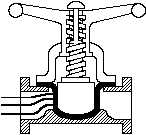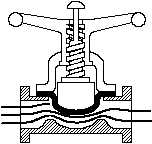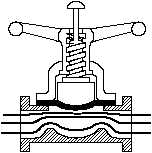TYPES OF VALVES
DOE-HDBK-1018/2-93
Valves
In a common, nonlubricated, plug valve having an elastomer sleeve, a sleeve of TFE completely
surrounds the plug. It is retained and locked in place by a metal body. This design results in
a primary seal being maintained between the sleeve and the plug at all times regardless of
position. The TFE sleeve is durable and inert to all but a few rarely encountered chemicals. It
also has a low coefficient of friction and is, therefore, self-lubricating.
Manually Operated Plug Valve Installation
When installing plug valves, care should be taken to allow room for the operation of the handle,
lever, or wrench. The manual operator is usually longer than the valve, and it rotates to a
position parallel to the pipe from a position 90 to the pipe.
Plug Valve Glands
The gland of the plug valve is equivalent to the bonnet of a gate or globe valve. The gland
secures the stem assembly to the valve body. There are three general types of glands: single
gland, screwed gland, and bolted gland.
To ensure a tight valve, the plug must be seated at all times. Gland adjustment should be kept
tight enough to prevent the plug from becoming unseated and exposing the seating surfaces to
the live fluid. Care should be exercised to not overtighten the gland, which will result in a
metal-to-metal contact between the body and the plug. Such a metal-to-metal contact creates an
additional force which will require extreme effort to operate the valve.
Diaphragm Valves
A diaphragm valve is a linear motion valve that is used to start, regulate, and stop fluid flow.
The name is derived from its flexible disk, which mates with a seat located in the open area at
the top of the valve body to form a seal. A diaphragm valve is illustrated in Figure 14.
Figure 14 Straight Through Diaphragm Valve
ME-04
Rev. 0
Page 24






